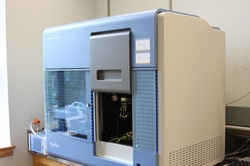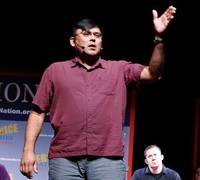 It’s a large but rather inconspicuous box, tinted a cerulean blue and resembling something like a space-shuttle refrigerator. But looks aren’t everything when it comes to the UO biology department’s high-tech $500,000 genome machine, which is capable of decoding DNA at a speed that was once unfathomable.
It’s a large but rather inconspicuous box, tinted a cerulean blue and resembling something like a space-shuttle refrigerator. But looks aren’t everything when it comes to the UO biology department’s high-tech $500,000 genome machine, which is capable of decoding DNA at a speed that was once unfathomable.
“You give it a little DNA and it’ll give you a sequence,” said UO biologist Eric Johnson. “The older machines used to read eight sequences at a time, and this one does 150 million at a time.”
It’s a technological leap forward that will accelerate our growing map of the world’s genetic codes, from salmon to the tiny bacteria that dwell in our digestive tract, and will open the door to new and profound discoveries.
Whereas the Human Genome Project took nearly a decade, billions of dollars and dozens of scientists working in concert, now with the genomics machine, a single genome can be sequenced by a lone scientist in a few months at a fraction of the cost.
Johnson’s work often involves sequencing chunks at thousands of strategic points on a particular DNA strand. He does this several times to get an accurate read, and while this doesn’t reveal all the nuances, as would a full genome sequencing of the entire strand, it can be used to identify the species of a particular sample or even help fine-tune the outcomes of propagation.
“We have used it to help identify the species of a whale from some of its tissue,” he said. “And we’re helping a company breed plants that are more nutritious and drought resistant.”
Assistant professor Bill Cresko’s lab uses the machine to pinpoint the places on a DNA strand that are influenced by natural selection. In particular, he has been looking at the DNA of the threespine stickleback in an effort to understand how it evolves in new, adverse environments.
“Identifying the genetic basis of evolution is one of biology’s holy grails, and it will help us understand, for example, how organisms will or won’t adapt to global climate change,” he said.
Other scientists are working on unraveling full genomes. Doctoral student Mike Miller, for instance, has received funding to sequence the genome of the steelhead and other salmonids, such as the Chinook and coho salmon. He believes his research can aid efforts to restore dwindling salmon populations.
“The hatchery fish are raised in a passive environment that selects for traits not conducive to surviving in the wild,” he said. “With a sequenced genome, we can help select for the traits that’ll keep the fish alive once they’re released.”
The machine slices up the DNA sample into a multitude of tiny pieces and analyzes each individual segment’s chemical makeup. DNA consists of two strands that are woven together with four different proteins.
The protein maps of each DNA piece are then projected onto a small monitor as small dots, the resulting image resembling a milky gossamer mass.
It requires several terabytes of computer space to record and store all these images, and biologists like Johnson use databases and computer scripts to analyze the voluminous amounts of data.
“It spits out a bunch of complicated chunks,” Johnson said. “It does this quickly but then you have to spend a lot of time putting it all together. The data are like the pieces to a jigsaw puzzle.”
The companies that make the genome machines are quickly spawning next-generation machines every few years, much like Apple and its iPhones. Because of this rapid iteration, Johnson says he can envision a future when there will be personalized genome sequencing, biopsy sequencing and any untold number of uses.
“There are important ethical questions we’ll have to answer as this develops,” he said. “But the technology should also really increase our knowledge of how to treat illnesses that are hereditary with gene-based therapies.”
— Marc Dadigan




 Learn how experts across disciplines are together advancing green chemistry.
Learn how experts across disciplines are together advancing green chemistry.